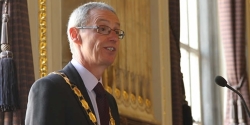

The construction industry and the building engineering services sector must continue to ensure they remain entirely fit for purpose in today's ever-changing business environment, according to the Building & Engineering Services Association.
Bruce Bisset, president of the B&ES, insisted that member businesses must adapt to changing working practices, in particular the use of Building Information Modelling, in his address at the B&ES President's luncheon yesterday (5 September).
“We must make sure that our businesses, and our industry, are fit for the challenges presented by the emergence of new technologies and the requirement for enhanced technical and managerial skills,” he said.
“We must continue to review the shape and structure of the workforce, to ensure that it remains fully in line with the needs of our industry and our clients.”
He added that industry must play its part in the implementation of the Industrial Strategy for Construction, which sets challenging targets in terms of cost reduction, project timescales and the minimisation of greenhouse gas emissions, and do everything it can to assist government in meeting its economic, commercial and environmental objectives.
These objectives would be achieved by supplying advice, guidance and good counsel in the many areas in which B&ES and its members possess unrivalled expertise and experience.
“We shall make sure that the policies proposed are both practicable and enforceable, and we shall demonstrate that our Association, our membership and our sector always deliver on their promises,” said Bisset.
As to the economic circumstances against which the sector is currently operating, he declared himself “just a wee bit more optimistic than my recent predecessors”.
The signs of recovery remain fragile and, in some cases, contradictory, he warned, but highlighted that recent statistics point to the possibility of increased construction output, if not by the end of this year, then in the first half of 2014.
“We can realistically hope for an end to the stalling of the business opportunities that should have been generated by the low-carbon agenda and the commitment to a sustainable built environment, as well as by initiatives such as the Green Deal and the Renewable Heat Incentive,” he said, confident in the promise of increasing investment, activity and workload across the board.
“Of course, we are aware that none of this will happen overnight,” he concluded. “Rather, it’s going to be a long, slow haul.”
If you'd like to keep up-to-date with the latest developments in the heating and plumbing industry, why not subscribe to our weekly newsletters? Just click the button below and you can ensure all the latest industry news and new product information lands in your inbox every week.